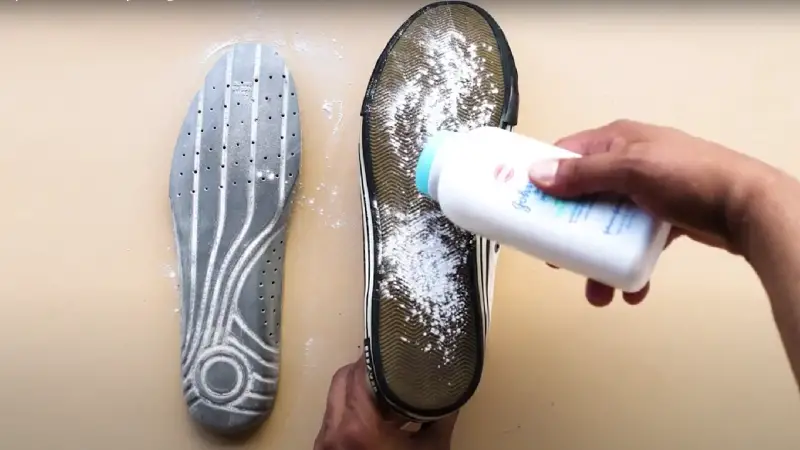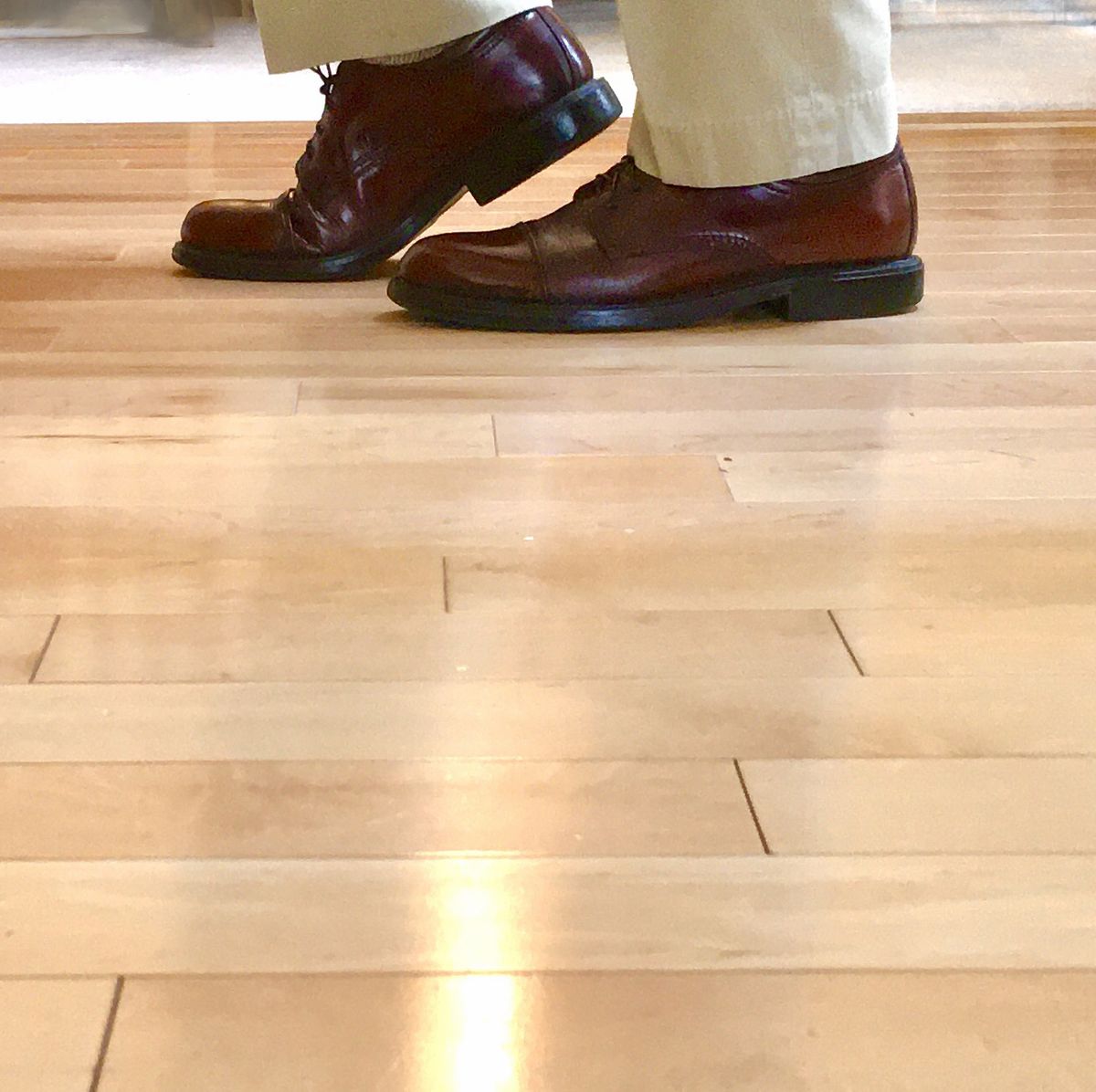To stop the bottom of shoes from squeaking on the floor, you can try dusting the soles with baby powder or rubbing them with a dryer sheet. Another option is to apply a small amount of silicone spray to the soles.
Are you tired of the embarrassing squeaking noise your shoes make on the floor? It can be quite frustrating, especially in quiet environments. Whether you’re at work, in a library, or during an important meeting, the squeaking can be distracting and even embarrassing.

But fear not, there are some simple and effective solutions to eliminate this annoying problem. We will explore various methods how to Stop the Bottom of Shoes from Squeaking on the Floor, allowing you to walk confidently and quietly wherever you go.
Understanding The Cause Of Squeaky Shoes
Squeaky shoes can be a nuisance, causing embarrassment and annoyance as you walk around. Understanding the cause of squeaky shoes can help you address the issue effectively. Let’s delve into why your shoes may be squeaking and how you can resolve this common problem.
Friction Between The Shoe Sole And The Floor
Friction between the shoe sole and the floor is a primary cause of squeaky shoes. When the sole of your shoe rubs against certain types of flooring, it can create a high-pitched squeak. This friction is often exacerbated by factors such as moisture or dust on the floor surface.
Air Trapped In The Shoe Sole
Air trapped in the shoe sole can also lead to squeaking noises. As you walk, air pockets within the sole can compress and release, causing a squeaking sound with each step. This trapped air is often a result of poor shoe construction or materials that do not allow for proper air circulation.

Credit: www.popularmechanics.com
Identifying The Type Of Shoe Squeak
Identifying the Type of Shoe Squeak is crucial in eliminating this annoying issue. Each type of squeak has its own solution, allowing you to apply the appropriate fix for your specific situation.
Squeak Caused By Wet Shoes
Wet shoes can often be the root cause of squeaking, as moisture gets trapped between the shoe and the floor. This type of squeak is sudden and usually consistent. In such cases, it’s essential to thoroughly dry the shoes and the affected area to eliminate the moisture causing the squeak.
Squeak Caused By New Shoes
New shoes are prone to squeaking due to the materials they are made from. This type of squeak tends to be more high-pitched and may occur randomly. To mitigate this, apply a small amount of baby powder or talcum powder to the insoles to reduce friction and silence the annoying squeak.
Squeak Caused By Wear And Tear
Wear and tear can lead to squeaking, as the components of the shoe start to deteriorate. This type of squeak is often irregular and can occur with each step. To address this issue, inspect the soles for any damage or debris and apply a lubricant such as silicone spray to reduce friction and quiet the squeak.
Fixes For Squeaky Wet Shoes
Squeaky wet shoes can be a nuisance, but there are simple fixes to silence them. By following these tips, you can ensure your shoes stop squeaking on the floor.
Drying The Shoes Properly
After getting your shoes wet, remove any excess moisture with a dry cloth. Stuff them with newspaper to absorb remaining dampness. Place them in a well-ventilated area to air dry thoroughly.
Applying Baby Powder Or Talcum Powder
Sprinkle baby powder or talcum powder inside the shoes liberally. Ensure the powder reaches all corners and crevices to absorb moisture and reduce friction, which causes squeaking. Allow the shoes to sit overnight to maximize the effects.</p
“`

Credit: www.amazon.com
Fixes For Squeaky New Shoes
When it comes to fixing squeaky new shoes, there are several effective solutions that can help you to stop the irritating noise and get back to enjoying your footwear in peace. Below, we’ll cover three simple and easy fixes for squeaky new shoes that you can try at home.
Using Leather Conditioner
If you have a pair of squeaky leather shoes, using a leather conditioner can help to eliminate the noise. Apply a small amount of leather conditioner to the inside and outside of the shoes, focusing on the areas where the squeaking is occurring. This will help to soften the leather and reduce friction, which can be the cause of the noise.
Applying Silicone Spray
Another effective solution for squeaky new shoes is to apply a silicone spray. Spray a light, even coating of silicone spray on the squeaky areas of the shoes and allow them to dry completely. The silicone will create a smooth, lubricated surface, reducing the friction that causes the squeaking.
Wearing Socks Or Adding Cushioned Insoles
If the squeaking is caused by the shoes rubbing against your feet, wearing socks or adding cushioned insoles can help to reduce the friction and eliminate the noise. The added layer of cushioning will create a barrier between your feet and the shoes, preventing them from rubbing together and causing the squeaking.
Fixes For Squeaky Worn Shoes
Dealing with squeaky shoes can be a frustrating and embarrassing problem. Thankfully, there are several fixes you can try to stop the bottom of your shoes from squeaking on the floor. In this section, we will discuss three effective remedies: replacing the worn-out outsole, applying shoe glue, and using lubricants like WD-40.
Replacing The Worn-out Outsole
Adding a new outsole to your worn shoes is a simple yet effective way to eliminate squeaks. The outsole is the bottom layer of the shoe that makes contact with the ground. Over time, this part can wear down or become damaged, causing squeaking noises. By replacing the worn-out outsole, you can restore the shoe’s grip and silence those annoying squeaks. Ensure you choose a high-quality outsole material to provide durability and effective noise reduction.
Applying Shoe Glue
Sometimes, squeaking can occur when the different components of the shoe come loose or rub against each other. Applying shoe glue to the problem areas can help secure and stabilize these parts, reducing friction and eliminating squeaks. Start by identifying the specific areas that are causing the noise, such as the insole or the midsole. Apply a small amount of shoe glue to these areas and press them together firmly. Allow the glue to dry properly before wearing the shoes again.
Using Lubricants Like Wd-40
Another solution for squeaky shoes is using lubricants like WD-40. These lubricants can reduce friction between the shoe components and eliminate squeaks. To apply, simply spray a small amount of the lubricant onto the bottom of the shoe. Make sure to cover the entire area that makes contact with the floor. Allow the lubricant to dry before walking. Keep in mind that some lubricants may leave a residue, so it’s a good idea to test a small area first.
Trying one or a combination of these fixes can help you get rid of the annoying squeaks and restore the silence to your shoes. Whether you choose to replace the worn-out outsole, apply shoe glue, or use lubricants like WD-40, you’ll be able to walk confidently without drawing attention to your squeaky shoes.
Preventing Future Shoe Squeaks
If you’ve dealt with the frustration of squeaky shoes before, you know how disruptive and embarrassing it can be. Thankfully, there are simple measures you can take to prevent future bouts of shoe squeaking. By regularly cleaning and maintaining your shoes, avoiding wet surfaces, and choosing shoes with non-slip soles, you can ensure a quieter and more confident stride. Let’s delve into each of these practices below.
Regularly Clean And Maintain Your Shoes
To keep your shoes squeak-free, it’s important to establish a regular cleaning and maintenance routine. Start by removing any debris or dirt from the soles of your shoes using a soft-bristled brush or an old toothbrush. If your shoes are made of leather, use a leather cleaner and conditioner to keep them supple and in top condition. For fabric or canvas shoes, a gentle wipe with a damp cloth and mild soap should suffice. This simple cleaning routine will not only help prevent squeaks but also extend the lifespan of your shoes.
Avoid Walking On Wet Surfaces
One of the main culprits for shoe squeaks is moisture. Walking on wet surfaces can seep into the soles and cause them to become squeaky. To avoid this problem, try to steer clear of damp or wet areas as much as possible. While it may not always be feasible to completely avoid wet surfaces, taking precautions like wearing waterproof or water-resistant shoes can significantly reduce the risk of water damage and subsequent squeaks. Remember, prevention is key.
Choose Shoes With Non-slip Soles
When selecting new shoes, opt for pairs that feature non-slip soles. These types of soles are typically made of rubber or other dense materials that provide excellent traction. Not only will they help prevent slips and falls on smooth surfaces, but they will also minimize the likelihood of squeaking. Shoes with non-slip soles tend to have better overall grip, ensuring a more comfortable and quiet walking experience.
By following these practices, you can take proactive steps to prevent future shoe squeaks. Regularly cleaning and maintaining your shoes, avoiding wet surfaces whenever possible, and choosing shoes with non-slip soles are simple yet effective ways to achieve a squeak-free stride. Incorporate these habits into your footwear routine and bid farewell to those pesky squeaks once and for all.

Credit: www.wikihow.com
Frequently Asked Questions Of How To Stop The Bottom Of Shoes From Squeaking On The Floor
Why Do My Shoes Squeak When I Walk In Them?
Shoes squeak when walking due to moisture, friction, or worn out soles causing rubbing sounds.
Why Do My Shoes Squeak On Laminate Floors?
The squeaking is caused by friction between the shoe’s sole and the laminate floor. It may be due to moisture, debris, or the material of the shoes. Regular cleaning and using a moisture-repelling spray can help reduce the squeaking.
How Do I Stop My Work Boots From Squeaking On The Floor?
To stop your work boots from squeaking on the floor, try these tips: 1. Apply a lubricant like baby powder or silicone spray on the bottom of your boots. 2. Insert insoles or cushioning to absorb vibrations that may cause squeaking.
3. Tighten the laces properly to reduce friction between the shoe and floor. 4. Clean the bottom of your boots to remove any dirt or debris. 5. Visit a professional cobbler if the squeaking persists.
How Do I Stop My Shoe Insert From Squeaking?
To stop your shoe insert from squeaking, try these simple steps: 1. Remove the insert and rub baby powder or talcum powder on both sides. 2. Apply a few drops of silicone lubricant or WD-40 on the squeaky areas. 3.
Press the insert firmly to reposition it in your shoe. 4. If the insert is worn out, consider replacing it with a new one.
Conclusion
Solving floor squeaking is a pesky issue. Follow the mentioned tips to eliminate shoe squeaking. By fixing the sole or adding insoles, these strategies typically work. Keep experimenting until the squeak is gone. Improving your shoes’ traction and sound reduction is vital.
Say goodbye to those annoying squeaky shoe noises!
